 Java
Java
 javaTutorial
javaTutorial
 What is the difference between using foreach and iterator to delete elements when traversing Java ArrayList?
What is the difference between using foreach and iterator to delete elements when traversing Java ArrayList?
What is the difference between using foreach and iterator to delete elements when traversing Java ArrayList?
1. The difference between Iterator and foreach
Polymorphic difference (the bottom layer of foreach is Iterator)
Iterator is an interface type, it does not care about the type of the collection or array;
Both for and foreach need to know the type of the collection first, even the type of the elements in the collection ;
1. Why is it said that the bottom layer of foreach is the code written by Iterator
:
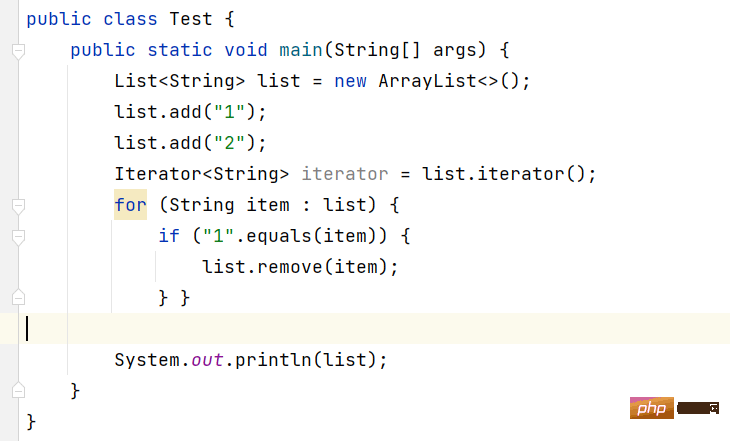
##Decompiled code:
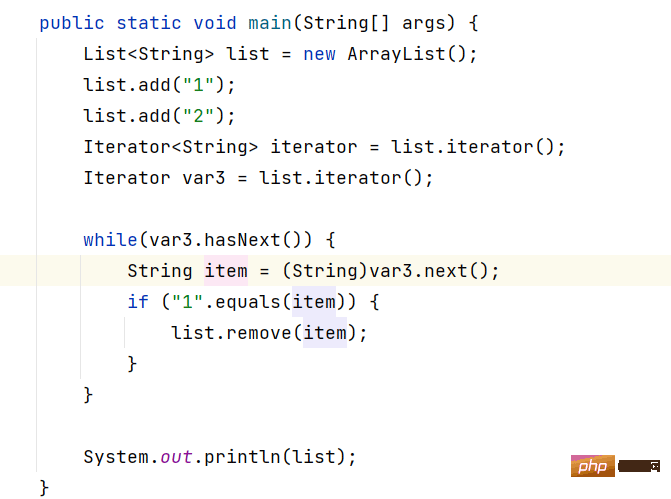
But no error will be reported in time 1, and an error will be reported in time 2 (java.util.ConcurrentModificationException)
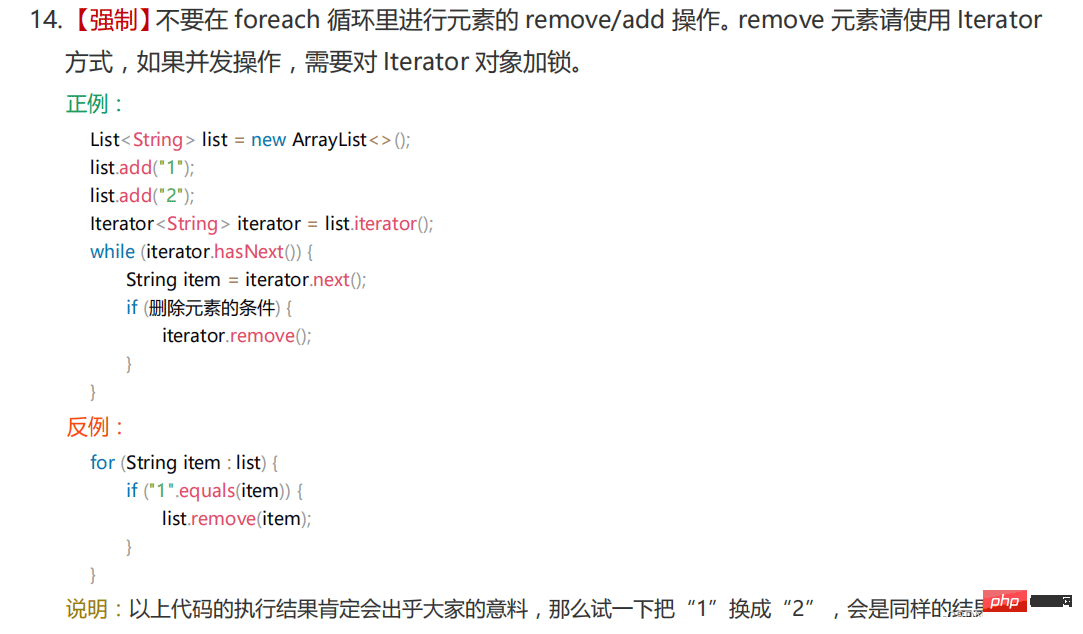
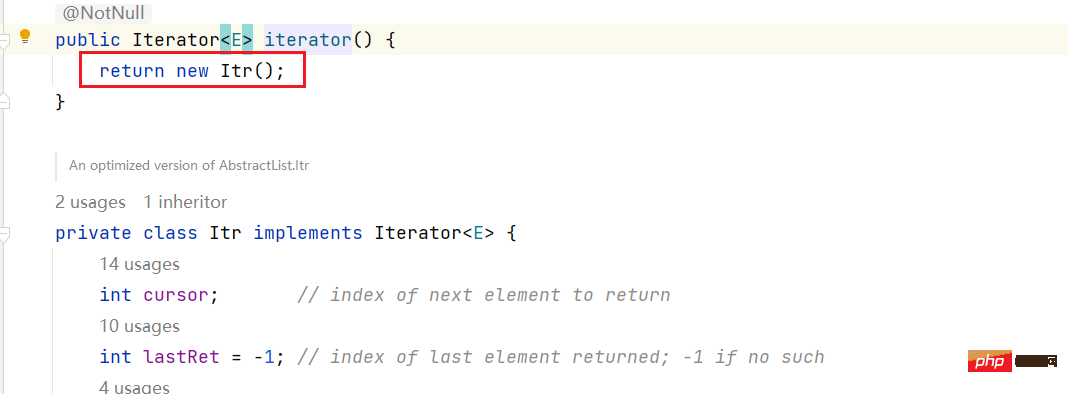 calls new Itr() to generate the Itr class (iterator). At this time, the three parameters of Itr will be initialized.
calls new Itr() to generate the Itr class (iterator). At this time, the three parameters of Itr will be initialized.
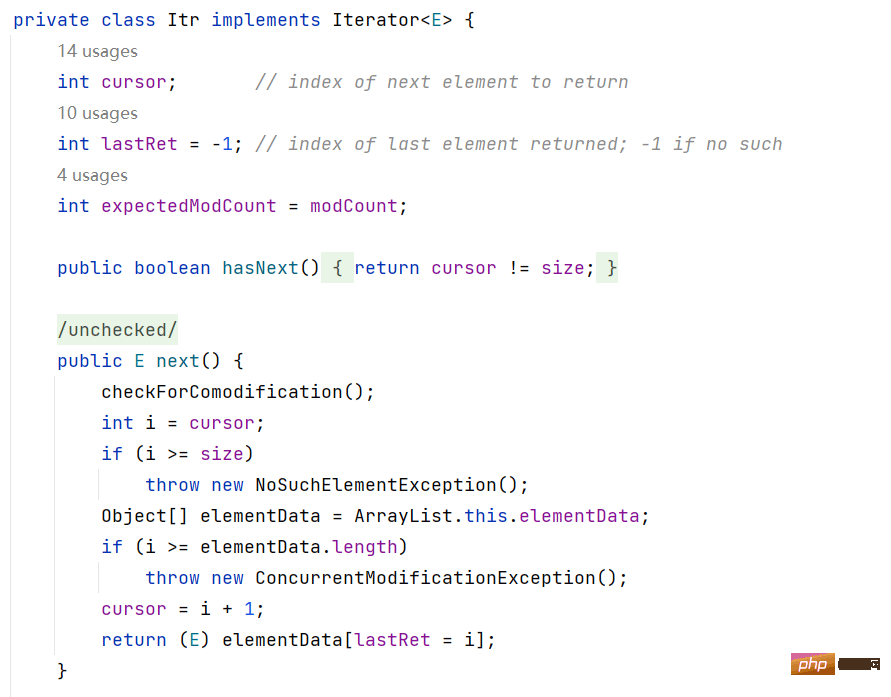
- cursor represents the next index position (starting at 0)
- size is the size of the collection (2)
When next method (), checkForComodification will be checked for equality
 modCount modification count (each add and remove will be 1) expectedModCount expected maximum count
modCount modification count (each add and remove will be 1) expectedModCount expected maximum count
1.remove operation source code analysis
First let’s take a look at deleting “2” Situation:First loop:
Because the modCount and expectedModCount at this time are both 2 (modCount is 2 because it was added twice), so no exception will be thrown in the first loop , exceptions are thrown when it is not the first time in the loop. After the next method is completed, the if condition of the remove method in the foreach loop method body is not satisfied, and the loop ends.
Second loop:
The hasNext and next methods of the second loop can be completed successfully. After that, it will enter the remove method in the foreach loop method body. To delete elements. At this time, size-1 becomes 1. In the fastRemove method in the remove method, modCount is set to 1, which becomes 3.
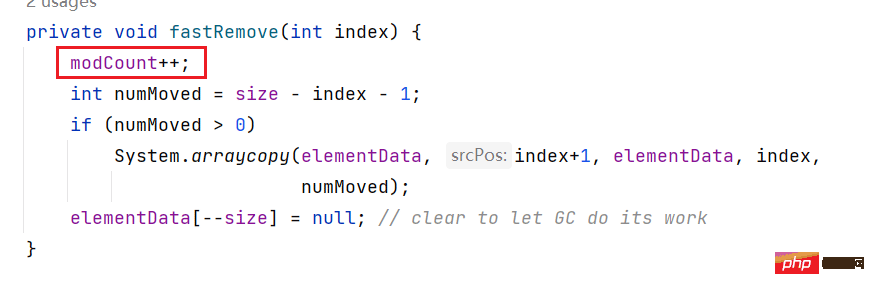
Then it will go to the hasNext method in the third loop. Under normal circumstances, this method will return false, but because the size at this time has changed to 1, and the cursor at this time is 2 (cursor represents the next index position), so the two are not equal, and an error is returned. true, so it will continue to go to the checkForComodification method in the next method to determine whether the modCount and expectedModCount at this time are equal. Because the modCount at this time has changed to 3, which is different from the expectedModCount value of 2, a ConcurrentModificationException exception was thrown here.
Let’s take a look at why no exception is thrown when deleting “1”:
Same as above, the modCount and expectedModCount at this time are both 2, so the hasNext and next methods in the first loop will not throw an exception. After this, you will enter the remove method in the foreach loop method body to delete the element. Same as above, size-1 becomes 1, and modCount 1 becomes 3.
The second loop:In the hasNext method of the second loop, the cursor at this time is 1, and the size is also 1, and they are equal. Therefore, when the hasNext method returns false, it will jump out of the foreach loop and will not go to the subsequent next method, so it will not throw an exception.
2. Source code steps
The first timeThe first sentence calls iterator(),
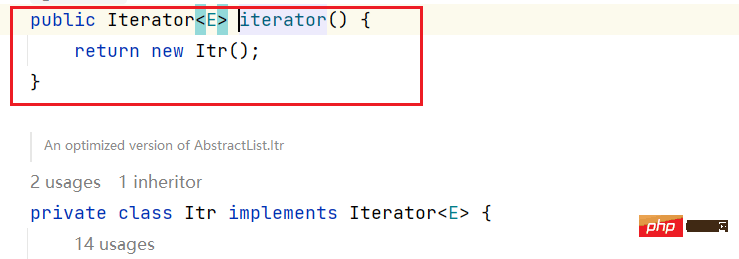 Call new Itr() to generate the Itr class (iterator). At this time, the three parameters of Itr will be initialized.
Call new Itr() to generate the Itr class (iterator). At this time, the three parameters of Itr will be initialized.
At this time expectedModCount == modCount == 2 (because the list mobilizes the add method, the add method will implement the operation on modCount)
The second sentence calls the hasNext() method below to return the subscript of the next element to be accessed. cursor, because it is the first loop, so the cursor is 0 and the size is 2 (0 != 2 true)
The next() method is called in the third sentence, and the if condition of the remove method in the foreach loop method body is not satisfied. , this ends the cycle
The second time
The second sentence calls the hasNext() method below and returns the subscript cursor of the next element to be accessed. Second loop, so the cursor is 1,
size is still 2 (1 != 2 true)
The third sentence calls the next() method, takes the value normally, and gets the first element "2";
Sentence ④ calls the remove() method and successfully deletes elements from the list. Note that when calling the remove method, there is modCount. All at this time, modCount3, expectedModCount2, size1
The third time
The second sentence calls the hasNext() method below and returns the subscript cursor of the next element to be accessed. , the second loop, so the cursor is 2 and the size is 1
The third sentence calls the next() method. Note that the first sentence in the next() method is to call checkForComodification(); due to modCount(3)! = expectedModCount(2), so an exception was thrown.
3. Why is iterator the bottom layer, why does foreach report an error

When the loop ends, while (iterator.hasNext() ) will check whether the next element exists. After remove delete 2 is completed, the next time you enter the cursor is still 1, and the size is also 1.
Foreach, after removing remove2, the next time you enter the cursor is 2, and the size is 1, so To return false, go to the next method, and then check, modCount=3, and expectedModCount=2
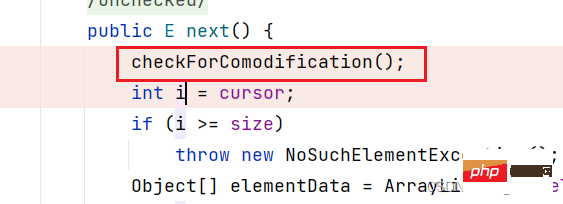

3. View the source code method
If you view the ArrayList under iterator

The above is the detailed content of What is the difference between using foreach and iterator to delete elements when traversing Java ArrayList?. For more information, please follow other related articles on the PHP Chinese website!

Hot AI Tools

Undresser.AI Undress
AI-powered app for creating realistic nude photos

AI Clothes Remover
Online AI tool for removing clothes from photos.

Undress AI Tool
Undress images for free

Clothoff.io
AI clothes remover

Video Face Swap
Swap faces in any video effortlessly with our completely free AI face swap tool!

Hot Article

Hot Tools

Notepad++7.3.1
Easy-to-use and free code editor

SublimeText3 Chinese version
Chinese version, very easy to use

Zend Studio 13.0.1
Powerful PHP integrated development environment

Dreamweaver CS6
Visual web development tools

SublimeText3 Mac version
God-level code editing software (SublimeText3)

Hot Topics
 1657
1657
 14
14
 1415
1415
 52
52
 1309
1309
 25
25
 1257
1257
 29
29
 1230
1230
 24
24
 Break or return from Java 8 stream forEach?
Feb 07, 2025 pm 12:09 PM
Break or return from Java 8 stream forEach?
Feb 07, 2025 pm 12:09 PM
Java 8 introduces the Stream API, providing a powerful and expressive way to process data collections. However, a common question when using Stream is: How to break or return from a forEach operation? Traditional loops allow for early interruption or return, but Stream's forEach method does not directly support this method. This article will explain the reasons and explore alternative methods for implementing premature termination in Stream processing systems. Further reading: Java Stream API improvements Understand Stream forEach The forEach method is a terminal operation that performs one operation on each element in the Stream. Its design intention is
 PHP: A Key Language for Web Development
Apr 13, 2025 am 12:08 AM
PHP: A Key Language for Web Development
Apr 13, 2025 am 12:08 AM
PHP is a scripting language widely used on the server side, especially suitable for web development. 1.PHP can embed HTML, process HTTP requests and responses, and supports a variety of databases. 2.PHP is used to generate dynamic web content, process form data, access databases, etc., with strong community support and open source resources. 3. PHP is an interpreted language, and the execution process includes lexical analysis, grammatical analysis, compilation and execution. 4.PHP can be combined with MySQL for advanced applications such as user registration systems. 5. When debugging PHP, you can use functions such as error_reporting() and var_dump(). 6. Optimize PHP code to use caching mechanisms, optimize database queries and use built-in functions. 7
 PHP vs. Python: Understanding the Differences
Apr 11, 2025 am 12:15 AM
PHP vs. Python: Understanding the Differences
Apr 11, 2025 am 12:15 AM
PHP and Python each have their own advantages, and the choice should be based on project requirements. 1.PHP is suitable for web development, with simple syntax and high execution efficiency. 2. Python is suitable for data science and machine learning, with concise syntax and rich libraries.
 PHP vs. Other Languages: A Comparison
Apr 13, 2025 am 12:19 AM
PHP vs. Other Languages: A Comparison
Apr 13, 2025 am 12:19 AM
PHP is suitable for web development, especially in rapid development and processing dynamic content, but is not good at data science and enterprise-level applications. Compared with Python, PHP has more advantages in web development, but is not as good as Python in the field of data science; compared with Java, PHP performs worse in enterprise-level applications, but is more flexible in web development; compared with JavaScript, PHP is more concise in back-end development, but is not as good as JavaScript in front-end development.
 PHP vs. Python: Core Features and Functionality
Apr 13, 2025 am 12:16 AM
PHP vs. Python: Core Features and Functionality
Apr 13, 2025 am 12:16 AM
PHP and Python each have their own advantages and are suitable for different scenarios. 1.PHP is suitable for web development and provides built-in web servers and rich function libraries. 2. Python is suitable for data science and machine learning, with concise syntax and a powerful standard library. When choosing, it should be decided based on project requirements.
 Java Program to Find the Volume of Capsule
Feb 07, 2025 am 11:37 AM
Java Program to Find the Volume of Capsule
Feb 07, 2025 am 11:37 AM
Capsules are three-dimensional geometric figures, composed of a cylinder and a hemisphere at both ends. The volume of the capsule can be calculated by adding the volume of the cylinder and the volume of the hemisphere at both ends. This tutorial will discuss how to calculate the volume of a given capsule in Java using different methods. Capsule volume formula The formula for capsule volume is as follows: Capsule volume = Cylindrical volume Volume Two hemisphere volume in, r: The radius of the hemisphere. h: The height of the cylinder (excluding the hemisphere). Example 1 enter Radius = 5 units Height = 10 units Output Volume = 1570.8 cubic units explain Calculate volume using formula: Volume = π × r2 × h (4
 PHP's Impact: Web Development and Beyond
Apr 18, 2025 am 12:10 AM
PHP's Impact: Web Development and Beyond
Apr 18, 2025 am 12:10 AM
PHPhassignificantlyimpactedwebdevelopmentandextendsbeyondit.1)ItpowersmajorplatformslikeWordPressandexcelsindatabaseinteractions.2)PHP'sadaptabilityallowsittoscaleforlargeapplicationsusingframeworkslikeLaravel.3)Beyondweb,PHPisusedincommand-linescrip
 PHP: The Foundation of Many Websites
Apr 13, 2025 am 12:07 AM
PHP: The Foundation of Many Websites
Apr 13, 2025 am 12:07 AM
The reasons why PHP is the preferred technology stack for many websites include its ease of use, strong community support, and widespread use. 1) Easy to learn and use, suitable for beginners. 2) Have a huge developer community and rich resources. 3) Widely used in WordPress, Drupal and other platforms. 4) Integrate tightly with web servers to simplify development deployment.



